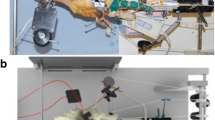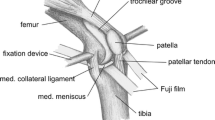Abstract
Purpose
The purpose of this in vitro study was to investigate the influence of different quadriceps loading patterns on tibiofemoral joint kinematics and patellofemoral pressure.
Methods
A dynamic muscle-loaded knee squat was simulated on eight knee specimens with an upright knee simulator while measuring tibiofemoral joint kinematics and patellofemoral pressure distribution. The quadriceps muscle was attached to three actuators simulating the three main extensor muscles, and five different quadriceps loading patterns were tested.
Results
Tibial axial and varus-valgus-rotation are affected most while changing quadriceps loading patterns from lateral to medial. Higher internal tibial rotation is associated with higher medial muscle load compared to the symmetrical loading condition. Contact force, contact area and maximum peak pressure rise with increasing flexion angles. Accentuating the vastus lateralis muscle induces a significant reduction in patellofemoral contact force and a 30% diminished contact area at 90° of flexion.
Conclusion
Strengthening the vastus medialis muscle leads to increased internal tibial rotation, thus optimizing patella tracking by lowering the Q-angle. In contrast, weakness of the vastus medialis muscle causes decreased tibial internal rotation and is associated with lower patellofemoral contact pressure and contact area. Vastus medialis exercise is advisable to improve patella tracking but may not be recommended in patients with disorders due to increased patellofemoral contact pressure.






Similar content being viewed by others
References
Amis AA, Senavongse W, Bull AM (2006) Patellofemoral kinematics during knee flexion-extension: an in vitro study. J Orthop Res 24:2201–2211
Biedert RM, Sanchis-Alfonso V (2002) Sources of anterior knee pain. Clin Sports Med 21:335–347
Bohnsack M, Borner C, Ruhmann O, Wirth CJ (2005) Patellofemoral pain syndrome. Orthopade 34:668–676
Boling MC, Padua DA, Marshall SW, Guskiewicz K, Pyne S, Beutler A (2009) A prospective investigation of biomechanical risk factors for patellofemoral pain syndrome: the Joint Undertaking to Monitor and Prevent ACL Injury (JUMP-ACL) cohort. Am J Sports Med 37:2108–2116
Chester R, Smith TO, Sweeting D, Dixon J, Wood S, Song F (2008) The relative timing of VMO and VL in the aetiology of anterior knee pain: a systematic review and meta-analysis. BMC Musculoskelet. Disord 9:64
D’Agata SD, Pearsall AW, Reider B, Draganich LF (1993) An in vitro analysis of patellofemoral contact areas and pressures following procurement of the central one-third patellar tendon. Am J Sports Med 21:212–219
Eckhoff DG, Brown AW, Kilcoyne RF, Stamm ER (1997) Knee version associated with anterior knee pain. Clin Orthop Relat Res 339:152–155
Elias JJ, Kilambi S, Goerke DR, Cosgarea AJ (2009) Improving vastus medialis obliquus function reduces pressure applied to lateral patellofemoral cartilage. J Orthop Res 27:578–583
Escamilla RF, Fleisig GS, Zheng N, Barrentine SW, Wilk KE, Andrews JR (1998) Biomechanics of the knee during closed kinetic chain and open kinetic chain exercises. Med Sci Sports Exerc 30:556–569
Flatow EL, Ateshian GA, Soslowsky LJ, Pawluk RJ, Grelsamer RP, Mow VC, Bigliani LU (1994) Computer simulation of glenohumeral and patellofemoral subluxation. Estimating pathological articular contact. Clin Orthop Relat Res 306:28–33
Goh JC, Lee PY, Bose K (1995) A cadaver study of the function of the oblique part of vastus medialis. J Bone Joint Surg Br 77:225–231
Huberti HH, Hayes WC (1984) Patellofemoral contact pressures. The influence of q-angle and tendofemoral contact. J Bone Joint Surg Am 66:715–724
Isear JA Jr, Erickson JC, Worrell TW (1997) EMG analysis of lower extremity muscle recruitment patterns during an unloaded squat. Med Sci Sports Exerc 29:532–539
Kuroda R, Kambic H, Valdevit A, Andrish JT (2001) Articular cartilage contact pressure after tibial tuberosity transfer. A cadaveric study. Am J Sports Med 29:403–409
Lattermann C, Drake GN, Spellman J, Bach BR Jr (2006) Lateral retinacular release for anterior knee pain: a systematic review of the literature. J Knee Surg 19:278–284
Lee TQ, Sandusky MD, Adeli A, McMahon PJ (2002) Effects of simulated vastus medialis strength variation on patellofemoral joint biomechanics in human cadaver knees. J Rehabil Res Dev 39:429–438
Li G, DeFrate LE, Zayontz S, Park SE, Gill TJ (2004) The effect of tibiofemoral joint kinematics on patellofemoral contact pressures under simulated muscle loads. J Orthop Res 22:801–806
Lieb FJ, Perry J (1968) Quadriceps function. An anatomical and mechanical study using amputated limbs. J Bone Joint Surg Am 50:1535–1548
Lin F, Wang G, Koh JL, Hendrix RW, Zhang LQ (2004) In vivo and noninvasive three-dimensional patellar tracking induced by individual heads of quadriceps. Med Sci Sports Exerc 36:93–101
MacIntyre NJ, Hill NA, Fellows RA, Ellis RE, Wilson DR (2006) Patellofemoral joint kinematics in individuals with and without patellofemoral pain syndrome. J Bone Joint Surg Am 88:2596–2605
Mori Y, Kuroki Y, Yamamoto R, Fujimoto A, Okumo H, Kubo M (1991) Clinical and histological study of patellar chondropathy in adolescents. Arthroscopy 7:182–197
Müller O, Lo J, Wünschel M, Obloh C, Wülker N (2009) Simulation of force loaded knee movement in a newly developed in vitro knee simulator. Biomed Tech (Berl) 54:142–149
Pagenstert GI, Bachmann M (2008) Clinical examination for patellofemoral problems. Orthopade 37:890–903
Salsich GB, Ward SR, Terk MR, Powers CM (2003) In vivo assessment of patellofemoral joint contact area in individuals who are pain free. Clin Orthop Relat Res 277–284
Sanchis-Alfonso V (2008) Patellofemoral pain. Orthopade 37:835–840
Sanchis-Alfonso V, Rosello-Sastre E (2003) Anterior knee pain in the young patient–what causes the pain? “Neural model”. Acta Orthop Scand 74:697–703
Senavongse W, Amis AA (2005) The effects of articular, retinacular, or muscular deficiencies on patellofemoral joint stability. J Bone Joint Surg Br 87:577–582
Souza RB, Draper CE, Fredericson M, Powers CM (2010) Femur rotation and patellofemoral joint kinematics: a weight-bearing magnetic resonance imaging analysis. J Orthop Sports Phys Ther 40:277–285
Thomee R, Augustsson J, Karlsson J (1999) Patellofemoral pain syndrome: a review of current issues. Sports Med 28:245–262
Waryasz GR, McDermott AY (2008) Patellofemoral pain syndrome (PFPS): a systematic review of anatomy and potential risk factors. Dyn Med 7:9
Acknowledgments
We thank Smith & Nephew for the financial support.
Conflict of interest
This study was partly funded by Smith & Nephew.
Author information
Authors and Affiliations
Corresponding author
Additional information
M. Wünschel and U. Leichtle contributed equally to this work.
Rights and permissions
About this article
Cite this article
Wünschel, M., Leichtle, U., Obloh, C. et al. The effect of different quadriceps loading patterns on tibiofemoral joint kinematics and patellofemoral contact pressure during simulated partial weight-bearing knee flexion. Knee Surg Sports Traumatol Arthrosc 19, 1099–1106 (2011). https://doi.org/10.1007/s00167-010-1359-y
Received:
Accepted:
Published:
Issue Date:
DOI: https://doi.org/10.1007/s00167-010-1359-y




